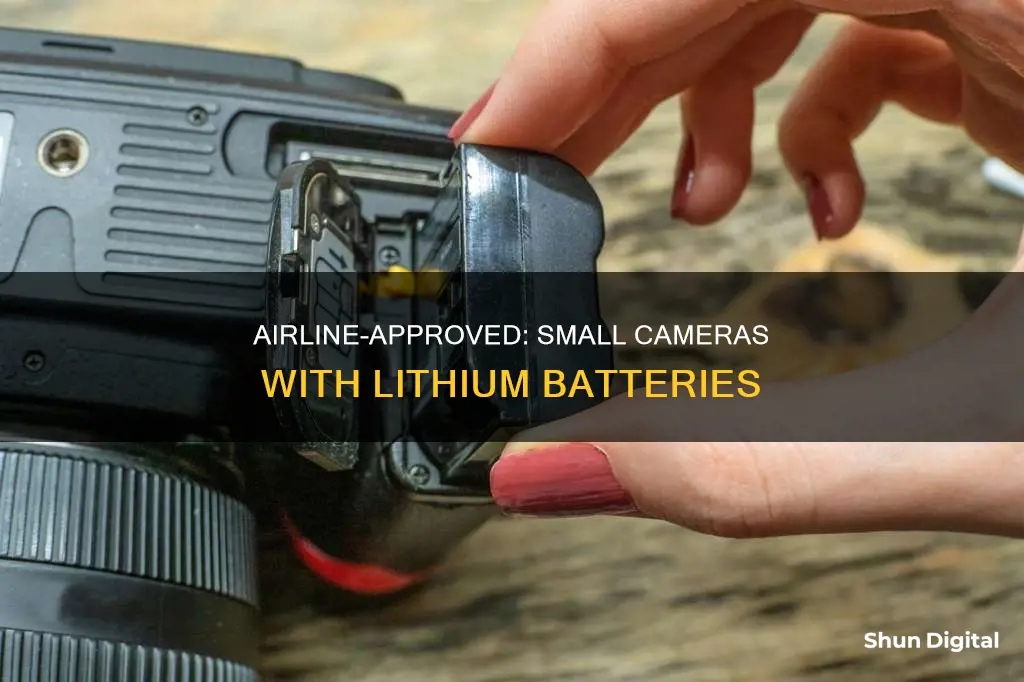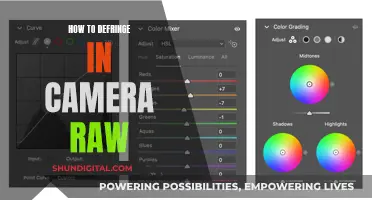
Small cameras with lithium batteries are generally allowed on airlines, but specific rules and restrictions may vary depending on the airline and aviation authorities such as the FAA, EASA, and TSA. It is crucial to check and comply with the regulations to ensure a safe and smooth travel experience.
| Characteristics | Values |
|---|---|
| Type of battery | Lithium-ion |
| Devices that use this battery | Cameras, smartphones, laptops, tablets, drones |
| Allowed on planes? | Yes, but with restrictions |
| Where to keep the battery | Carry-on baggage |
| Battery weight limit | 100Wh |
| Number of batteries allowed | No restriction on small dry cells batteries; 2 spare lithium-ion batteries |
| Battery packaging | Must be shielded from harm and short circuits; original packaging or tape over charging interface/connectors |
| Damaged/defective batteries | Not allowed |
What You'll Learn

Lithium-ion batteries are allowed in carry-on luggage
Firstly, it is important to note that lithium-ion batteries installed inside electronic devices such as cameras, smartphones, laptops, and tablets are generally considered safe and can be transported in carry-on luggage without any issues. However, if these devices are packed in checked baggage, they should be turned off, protected from accidental activation, and packed securely to prevent damage.
For spare or uninstalled lithium-ion batteries, the guidelines are more stringent. These batteries must be carried in carry-on baggage and are not allowed in checked luggage. This is because loose lithium batteries in the cargo hold pose a fire hazard without the presence of passengers or crew to intervene and stop the fire. To prevent short circuits, it is crucial to protect the battery terminals by using the manufacturer's packaging or covering the terminals with tape. It is also recommended to place the batteries in separate bags for added protection.
There are quantity and capacity restrictions for lithium-ion batteries. Each passenger is limited to carrying a maximum of two spare lithium-ion batteries. The watt-hour limit per battery is typically 100 Wh, but with airline approval, passengers may carry larger batteries of up to 160 Wh. It is important to note that these regulations may vary slightly depending on the airline and the country, so it is always advisable to check with the specific airline before your trip.
When packing lithium-ion batteries, it is essential to take precautions to ensure safety. Damaged, defective, or recalled batteries that are likely to be a safety concern by overheating or catching fire must not be carried in either carry-on or checked baggage. Always ensure that the batteries are protected from damage and short circuits, and mark them clearly for ease of identification during customs checking.
Charging the Kodak EasyShare Z650: A Step-by-Step Guide
You may want to see also

Lithium-ion batteries are prohibited in checked luggage
The Federal Aviation Administration (FAA) in the United States has strict guidelines regarding the transportation of lithium-ion batteries on planes. The FAA states that devices containing lithium-ion batteries should be kept in carry-on baggage. If these devices must be packed in checked baggage, they should be turned off, protected from accidental activation, and packed to prevent damage.
Uninstalled or spare lithium-ion batteries are not allowed in checked baggage and must be carried in carry-on luggage. This is because loose lithium-ion batteries in the cargo hold pose a significant fire hazard. If a fire occurs in the cargo hold, it may go unnoticed until it is too late. By keeping these batteries in the cabin, passengers and crew can quickly respond to any incidents.
To ensure safe transportation, it is crucial to protect the battery terminals. This can be done by using the manufacturer's packaging or covering the terminals with tape. Additionally, batteries should be stored in separate bags to prevent short circuits.
It is also important to check for recalls or damage to lithium-ion batteries before travelling. Damaged or defective batteries that are likely to overheat or catch fire must not be carried on planes at all.
Lithium-ion batteries have revolutionized portable electronics, but special care must be taken when travelling with these devices to ensure the safety of everyone on board.
Charging Camera Battery Packs: A Step-by-Step Guide
You may want to see also

Battery terminals should be protected
Small cameras with lithium batteries are generally allowed on airlines, but there are specific rules that must be followed for safety reasons. Lithium-ion batteries are considered dangerous goods due to their potential to short-circuit or catch fire. Therefore, it is crucial to protect the battery terminals to prevent short circuits. This can be done by taping the charging interfaces or connectors, or by using the manufacturer's packaging. Additionally, it is recommended to place the batteries in separate bags for further protection.
- Before protecting the battery terminals, it is important to check the type of battery and identify the positive and negative terminals. Positive battery cables are usually red, while negative ones are black. Positive terminals may also be marked with “POS” or a "+" sign, while negative terminals may have “NEG” or a "-" sign.
- When removing the battery terminals, it is recommended to wear rubber gloves for safety. Start by removing the negative terminal first, then the positive terminal. It is important to detach the terminals quickly to prevent any electric sparks.
- After removing the terminals, you can apply anti-corrosion washers or dielectric grease on the battery posts and cable connectors. This will help prevent future corrosion and build-up.
- Some sources suggest using a heavy-duty cleaner and a steel wool or wire brush to remove any corrosion or buildup on the battery terminals. This can be done before or after taping the terminals, depending on their condition.
- Once the terminals are clean and protected, reconnect the cables in the correct order. Connect the positive terminal first, then the negative terminal.
- Regularly check your battery terminals for any signs of corrosion or damage. If you notice any corrosion, clean the terminals and apply dielectric grease or another anti-corrosion chemical.
- If you are not comfortable working with batteries, it is recommended to consult a service professional. Improper handling of batteries can create sparks and cause damage.
By following these instructions, you can help ensure the safety of your small camera's lithium battery when travelling on an airline and prevent any issues related to battery corrosion or short-circuits.
Charging Your 360 Fly Camera: A Quick Guide
You may want to see also

Damaged batteries are not allowed
When flying, it's important to remember that damaged batteries are not allowed. This is because lithium batteries, which are commonly used to power everyday devices, can catch fire if they are damaged or if their terminals are short-circuited. As a result, damaged batteries are considered a safety concern and are not permitted in carry-on or checked baggage.
Lithium batteries are found in many devices, including smartphones, laptops, tablets, and camera equipment. These batteries are generally considered safe when installed inside devices. However, if a lithium battery becomes damaged, it can pose a serious risk. For this reason, it is crucial to inspect your batteries before travelling and dispose of any that show signs of damage, such as swelling or leakage.
If you discover a damaged battery during your journey, it is important to dispose of it properly and not take it on an aircraft. This is because damaged batteries can overheat or catch fire, which could lead to a dangerous situation on board. It is always better to be cautious and replace a damaged battery with a new one rather than risk a safety incident.
To ensure the safety of all passengers and crew, it is essential to follow the guidelines provided by aviation authorities, such as the FAA or EASA. These organizations provide specific rules and recommendations for travelling with lithium batteries to prevent any potential hazards. By following these guidelines, you can help ensure a safe and enjoyable journey for everyone.
In addition to the restrictions on damaged batteries, it is worth noting that there are also quantity and capacity limits for lithium batteries. Each passenger is typically allowed to carry a limited number of spare lithium-ion camera batteries, and these batteries must be protected from damage and short circuits during transport. It is the responsibility of travellers to familiarise themselves with the latest regulations and take the necessary precautions to ensure a safe trip.
Charging Camera Batteries: DIY Home Hacks
You may want to see also

Regulations vary by airline
When it comes to flying with small cameras that have lithium batteries, regulations do vary by airline. While some airlines may allow you to carry on a certain number of lithium-ion batteries, others may have more stringent restrictions. It is always best to check with your specific airline before your trip to ensure you are compliant with their policies.
In general, lithium-ion batteries are considered a safety risk due to their potential for rapid combustion. As a result, most airlines and aviation authorities, such as the Federal Aviation Administration (FAA) and the European Union Aviation Safety Agency (EASA), recommend that devices containing these batteries, including cameras, be kept in carry-on baggage. This allows passengers and cabin crew to take immediate action in the event of a smoke or fire incident involving lithium batteries.
When packing lithium-ion camera batteries, it is important to take precautions to prevent short circuits. This can be done by using the original packaging or by covering the battery terminals with tape. Storing batteries in separate bags provides additional protection and makes it easier to identify and access them during security checks.
It is also worth noting that some airlines may have weight and size restrictions for carry-on baggage, which could impact the number of camera batteries you are allowed to bring on board. Additionally, regulations may change over time, so it is always advisable to stay up to date with the latest guidelines provided by your airline and relevant aviation authorities.
Furthermore, different countries may have varying rules regarding the transportation of lithium-ion batteries. While some countries may align with the recommendations of the FAA or EASA, others may have more stringent restrictions. For instance, shipping or mailing lithium batteries internationally can be challenging due to varying customs regulations.
To ensure a smooth travel experience, it is crucial to be well-informed about the specific regulations of the airline you are flying with, as well as the countries you are travelling to and from. By following the guidelines and taking the necessary precautions, you can safely transport your camera equipment, including lithium-ion batteries, on your next flight.
Eufy Camera Charging: Know When It's Fully Charged
You may want to see also
Frequently asked questions
Yes, you can bring your small camera with a lithium battery on a plane, but there are specific rules you must follow. Lithium batteries are considered dangerous goods due to their potential to short-circuit or catch fire.
It is recommended to check the guidelines of the specific airline you are flying with, as well as the regulations of aviation authorities such as the FAA, TSA, EASA, and IATA. In general, lithium-ion camera batteries within 100Wh are allowed in carry-on luggage but must be protected from damage and short circuits.
It is important to pack your camera and battery safely. Tape over the charging interface or connectors to prevent short circuits, and store the battery in its original packaging or a separate bag to avoid contact with metal items.







